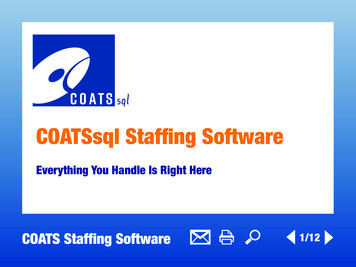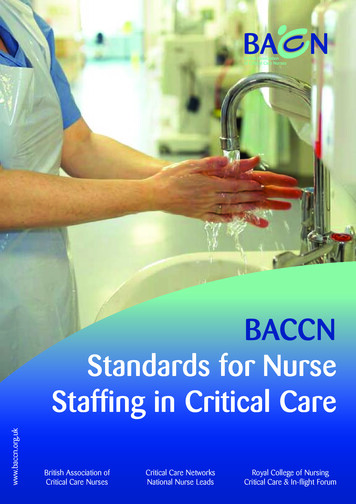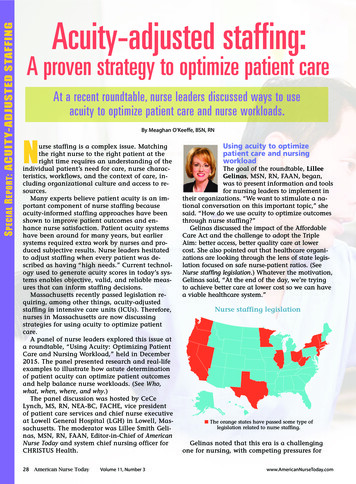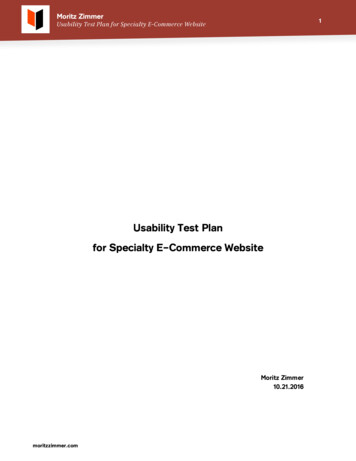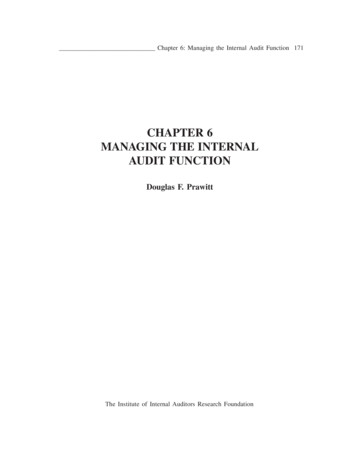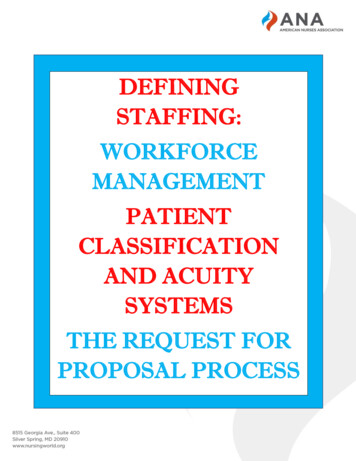
Transcription
ICATIONAND ACUITYSYSTEMSTHE REQUEST FORPROPOSAL PROCESS
AcknowledgmentsThis endeavor was sponsored by the American Nurses Association. ANA wishes toacknowledge the following individuals for their expertise in the development of thisproduct: John Alis, Senior Consulting Sales Executive (Cerner) Scott Allison, Manager, Marketing & Communications, Consultant (Avantas) Deborah Crist-Grundman, BSN, RN, Senior Clinical Strategist (Catalyst Systems) Holly De Groot, PhD, RN, FAAN, Chief Executive Officer (Catalyst Systems) David Faller, Vice President Nursing Solutions (QuadraMed) Chris Flanders, Director Healthcare (Axsium) Amy Garcia, MSN, RN, Director and Chief Nursing Officer (Cerner) Nick Haselwander, Marketing Director (ShiftWise) Karlene Kerfoot, PhD, RN, NEA-BC, FAAN, Chief Nursing Officer (API Healthcare a GECompany) Bre Loughlin, BN, RN, Clinician (Epic) Beth Meyers, RN, PhD(c), CNOR, Chief Nurse Executive & Analytics Strategy Director (InforHealthcare) Danielle Miller, PhD(c), MSN, RNC-OB, C-EFM, Chief Nursing Officer (Infor Healthcare) Gia Milo-Slagle, Director, Product Management: Capacity and Workforce Solutions(McKesson) Shane Parker, RN, Co-Founder (ShiftWizard) Jacob Robinson, Software Developer (Epic) Pam Sapienza, RN BSN, MBA, FACHE, Director of Healthcare (Navigant) Gaylyn Timiney, MSN, RN, Senior Clinical Operations Consultant (Kronos) Heather Wood, Senior Product Manager (QuadraMed)ANA Staff Mary Jo Assi, DNP, RN, NEA-BC, FNP-BC, FAANNick BlencoweElizabeth FranzinoSharon Morgan, MSN, RN, NP-C
IntroductionGreater adoption of Health Information Technology (HIT) providesopportunities to use electronic Staffing and PatientClassification/Acuity systems to go beyond inflexible ratios; and givesvisibility to factors influencing staffing needs such as varying levels ofpatient care requirements, nursing skill mix, and patient assignments.1This resource will walk through three key concepts to consider whenevaluating software solutions: Workforce Management (Staffing)Systems, Patient Classification/Acuity Systems, and the Request forProposal (RFP) process. Workforce ManagementPrinciples, Values, Responsibilities:Staffing impacts the ability of all nurses to deliver safe, quality care atevery practice level and in all practice settings: Nursing care delivery is multifaceted Appropriate nurse staffing determination is complex1,2Nurses have a professional duty to be knowledgeable about staffing,its processes and organizational functions,as part of their responsibility to patients.While nurse managers and other leadersmay be accountable to their organizationfor nurse staffing, all nurses areaccountable to their patients andprofession.3 Nurse leaders seek to makeappropriate staffing assignments bymatching resources to patientsbased on3:
o patient care needso staff skill mixo educationo competencieso unit variables Much of the process can be automated1Today, everyone from the CNO to the frontline nurse mustunderstand the relationship between staffing, cost, and patient, staffand organizational outcomes.There are four phases to the staffing process: Forecasting (includes budgeting and planning)SchedulingStaffingImproving (monitoring and analyzing outcomes)Scheduling and staffing operationalize the budget plan, while theprocess of improving and adjusting based on this analysis ensures thedelivery of safe quality care in a cost effective manner.Staffing and scheduling systems ease every phase of the process: Systems translate policies, staffing data and evidence intobusiness rules to drive schedule creation Automated systems assist in promoting staff satisfactionsurrounding perceptions of fairness for the actual work schedulealong with the process used to generate that schedule4 Systems facilitate effective communication, active staffparticipation and increase staff autonomy and satisfaction Systems alert managers of variances and urgent staffing issues,and provide dashboards and reports that help monitorproductivity
Systems simplify and automate the processes that increaseefficiency and provide reliable and valid data to decision-makersacross many units/departments and settings Forecasting: Shape a plan for current and future operationalrequirements by analyzing organizational structure and policies,operational variables, and staffing data.
Scheduling: Determine a set number and type of staff to beallocated for an anticipated workload and defined future timeperiod, typically four to twelve weeks. Translate budget and forecastinto a tactical plan for meeting expected patient volumes, serviceand care requirements.
Staffing: Day-to-day operations that assess and determine the shiftallocation of nursing resources to ensure adequate staffing on eachshift and unit/department. Typically occurs within 4 to 48 hours of thework shift.
Improving: Monitor, analyze and evaluate staffing actions to plan inreal-time, near-time and retrospective intervals. Identify trends andpatterns that inform and refine scheduling and forecast planning. Patient Classification/Acuity SystemsBackgroundDetermining the right number and type of nursing staff required tomeet patient care needs historically is viewed as the foundation of
workforce management systems5, 6. From Florence Nightingale’sinitial efforts to assign patients to particular wards based on severityof illness7 to more focused studies from the 1960’s forward, the needfor accurate data on patient care requirements has continued togrow. Data impact all aspects of workforce management:o Forecastingo Schedulingo Staffingo Improving Directly affects patient care quality, safety, and effectivenessby compensating for shift variations in care needs “A growing body of evidence shows that patient acuity-drivenstaffing is an effective way to optimize nurse staffing toimprove patient outcomes and promote clinical andorganizational excellence”8.TerminologyThe term Patient Classification Systems refers to measurementsystems in nursing that reflect actual patient care needs for staffingpurposes. The term also is referred to as Acuity Systems, although theconcept of “Acuity” denotes unidimensional illness severity in themedical sense. A literature review demonstrates that the majority ofthe nursing community continues to prefer the more inclusive termPatient Classification to reflect the broader bio-psycho-socialspiritual mandate of nursing. Therefore, for purposes of this discussion,the term Patient Classification/Acuity System is used.Operational DefinitionA Patient Classification/Acuity System (PCAS) is defined as “themethods and processes of determining, validating and monitoringindividual patient/family care requirements over time in order to
assist in such determinations as: unit staffing, patient assignments,case mix analysis, budget planning and defense, per patient cost ofnursing services, variable billing and the maintenance of qualityassurance standards”9: Includes critical system elements as well as various ways theresulting data can be used.o confirms that a tool or measure with rules and definitionsis used to determine patient care requirementso includes processes for validating and monitoring themeasure and its outcomes over time PCAS data can be used for:o unit staffingo equal workload distributiono quality of care maintenanceo budget developmento costing out careo organizational processesTypes of Patient Classification/Acuity System MeasuresThree basic types of PCAS tools can be identified, with differentphilosophical assumptions. Each type defines nursing care for theorganization and aims to capture the fluctuations in patient carerequirements in a different way. Each tool type is designed toconnect to staffing and scheduling in various ways, with the goal ofassuring the right number and type of staff needed to care for anygiven patient group.Prototype ToolsThe first type of PCAS measure is the Prototype approach. Thismethod describes different patient care levels in general terms suchas “Minimum, Moderate, or Maximum care” and is oftenaccompanied by care levels, such as “1 Minimum Care, 2
Moderate Care, and 3 Maximum Care.” A brief description of thedifferent care requirements at each level is usually provided as well.The determination of the patient care level is ultimately a subjectivematching of the actual care needs with the prototype descriptionthat most closely matches the actual patient care requirements. Assuch, there is no actual tool that gets completed9, 10. This approachhas also been defined as “a descriptive method using severalmutually exclusive and exhaustive categories of care”11.Staffing by patient ratios or grids can also be viewed as anotherPrototype approach. However, as Bolton and her colleaguespointed out, 12 fixed staffing numbers or ratios only identify minimumstaffing levels and do not adjust for the ever changing nature ofpatient care needs. As such, ratios alone are insufficient for staffingpurposes.Summative Task ToolsThe second major type of PCAS measure is known as the SummativeTask approach. These measures are task and frequency-based andassume that patient care requirements are best expressed as thesum of a series of observable tasks and activities. Each task isassigned a weight or number of points that is ultimately expressed asan increment of time such as minutes or hours. Those minutes orhours are added up, converted to hours, and are used to project thenumber of staff that generally equate to those hours9, 10.Care Interaction ToolsThe third type of Patient Classification/Acuity measures are known asCare Interaction tools. This approach to PCAS is based onconceptually distinct categories of patient care requirements orattributes rather than on individual tasks or activities. The criticalindicators associated with this type of measure assume that careneeds are a function of a complex interaction between various
bio/psycho/social/spiritual dimensions of care, including the “type,frequency, duration, and complexity of the particular patient carerequirements” 9. For example, the care needs on a particular toolmight relate to cardiovascular function, mental status, socialsupport, and ADLs. Care Interaction tools view patient care asgreater than the simple sum of individual patient care tasks and assuch require the greatest degree of professional judgement of thePCAS tool types9, 10 . However, the broad scope of the care needsidentified typically results in fewer indicators overall.Design Principles for Patient Classification/Acuity SystemsImportant Design Principles have been identified for PCAS13. TheseDesign Principles include the following:Validity and ReliabilityValidity and reliability are perhaps the most important yetmisunderstood elements of the Design Principles. A PatientClassification/Acuity tool or measure is considered valid if it actuallymeasures what it is designed to measure, and in this case thatmeans different levels or amounts of patient care that vary in thepredicted direction. For example, assume that a nursing unit is usinga 3 level PCAS tool, with level 1 representing minimum care, level 2indicating a moderate level of care, and a level 3 representing themaximum amount of care on a unit. If patient care is then studiedand the results show that on average, patient care increases witheach increase in patient care level, that result is direct evidence ofvalidity. So if a study then shows that level 1 patients get less carethan other level patients, and a level 2 patient gets more than alevel 1 but less care overall than level 3 patients, the tool is validbecause that the care varies in the predicted directions. Using aPatient Classification/Acuity tool that does not have establishedvalidity is to be avoided at all costs because of the lack of credibleevidence that the tool actually works, even when staff are using it
correctly. Using invalid PCAS measures will result in erroneous andincomplete estimates of actual patient care requirements,potentially affecting projected staffing levels and the resulting carequality. Validity should always be well established using soundresearch methods when a tool is first developed and periodicallythereafter. The moral and scientific responsibility to create valid toolsfalls to the developing organization, whether an individual hospital,healthcare system, or private company offering the PCAS on theopen market.Reliability of a Patient Classification/Acuity tool means that if themeasure is valid and being used correctly, the results of the ratingsshould be accurate and dependable. For example, if three differentnurses who all know the care requirements of a particular patientseparately rated his care needs using the same valid PatientClassification/Acuity tool, they should all choose the same indicatorsand end up with the same patient rating. When a tool isdependable and you can count on the ratings being correct, it isconsidered to be reliable.It is also extremely important to understand the critical relationshipbetween validity and reliability. A tool might start out with strongevidence of validity, but if it is used incorrectly, the ratings willbecome incorrect and thus unreliable. Unreliable ratingsautomatically render any PCAS tool invalid. This crucial relationshipmust be well understood from the start and form the basis forongoing staff education and reliability and validity monitoring forPCAS tools and measures over time.The importance of validity and reliability for PCAS tools cannot beoverstated. In fact, it has been observed that PatientClassification/Acuity System measures have all too often lackedevidence of validity and reliability9,10,14,15. In order to assure that thePCAS tools used in healthcare are as sound as possible, the validity
and reliability of these systems should be well established when it isinitially developed and/or purchased, and the ongoing reliability ofpatient ratings should be assessed at least annually for every staffmember rating patients with a given measure. In addition, adescription of the research methods used to demonstrate validityand reliability should be provided and reviewed beforeimplementation in a healthcare setting is seriously contemplated.Simplicity and EfficiencyThe need for simplicity and efficiency in a PatientClassification/Acuity System is critical to maintain overall systemeffectiveness and not add unnecessarily to nursing’s workload. Tothat end is the scientific principle of parsimony, capturing the totalityof care with as few indicators as possible, thereby achieving thegold standard of simplicity and elegance. Practically speaking, thismeans that more items or indicators on a tool are not necessarilybetter13. In fact, the Simplicity and Efficiency Design Principle canonly be met by a PCAS tool “that is conceptually clear, concise, andtime-efficient to use” 9, 10. Simplicity, efficiency, and the visibility ofthe tool and its indicators ultimately drive the overall usefulness of themeasure.PCAS measures that are embedded in the documentation systemsof an electronic health record (EHR) are often in the backgroundand not immediately visible to the nurse. As with any type of PCASunder consideration, it is critical that the nursing members of thesystem selection team see a total listing of the tool indicators, theassociated weighting scheme, as well as a full description of themethodology so that they understand exactly how the care levelsare calculated. Patient Classification/Acuity Systems should neverbe selected without this type of demonstration and level ofunderstanding. This process will also assist in determining how muchthe system meets the Simplicity and Efficiency Design Principle.
ObjectivityAnother important Design Principle to look for in a PatientClassification/Acuity System is that it should allow for ease inobjective verification of tool ratings as well as the tool validationprocess13. This can be best achieved by having someone with bothnursing and measurement expertise involved in the development ofthe measure.AcceptabilityIt has been observed that the acceptability of PCAS measures isimportant to colleagues both inside and outside the nursingdepartment. For members of the nursing team, acceptability is afunction of how well the measure appears to capture the essence ofnursing and patient care. This also implies the exercise of subjectivenursing judgement in rating patient care needs13. When the PatientClassification/Acuity System is acceptable to nursing, acceptabilityin other critical departments such as Finance will occur as they arealso educated about the system, how it can be used, the selectionprocess and rationale, as well as ongoing system monitoringprocesses 9, 10. The importance of this step is crucial to anyhealthcare organization because of the important assertion that“valid and reliable PCAS’s define and defend the work ofprofessional nursing practice, protect patients from complications,and decrease the vulnerability of nurse staffing to budget cuts”17. Assuch, the care indicators on a PCAS tool must be visible andrepresent the full scope of nursing practice and patient care.Tool DevelopmentIt is essential that when a Patient Classification/Acuity System is underdevelopment that a registered nurse with doctoral level expertise inmeasurement methods or an RN working directly with someone withthat expertise has been involved throughout the tool development
process. This helps assure that patient care and nursing’s scope ofpractice are well understood and represented by the PatientClassification/Acuity measure. It also assures stronger validity andreliability of the PCAS tool at the start. In addition, access toregistered nurse clinical experts for feedback and testing throughoutthe development process is also critical if the system is toappropriately define nursing care and meet the intent of this criticalDesign Principle.Nursing WorkThis final Design Principle offered by Fasoli, Fincke, and Haddock13 isfundamental to a well-conceived, fully relevant PatientClassification/Acuity System for nursing. This principle involves thecommon knowledge and central belief that nursing work is muchgreater than the simple sum of individual tasks. Keeping this coreknowledge and understanding of the interactive nature of nursingpractice in mind and making sure it is incorporated throughout thesystem development, application, and utilization phase will helpassure a system that works for nursing, the organization, and thepatients it serves.Keys to Successful ImplementationIn order to fully implement and maintain a PatientClassification/Acuity System so that it informs staffing decisions in themost complete way, eight Keys to Successful Implementationreflecting best practices in evidence-based leadership must beapplied to the process9,10,18,19. The eight keys are:CommitmentCreating and fostering high level commitment to make the systemwork as well as it possibly can at all levels of the organization isessential. Starting with the nursing leadership team, enthusiasm canbe encouraged by education about the system and how it can help
each nurse, patient, and the organization on a daily basis.Commitment is contagious. Since commitment is evidenced byaction, assessing commitment levels of all staff should be an ongoingprocess so that it can be influenced as needed.ClarityAssuring there is widespread clarity and understanding about thepurpose of the Patient Classification/Acuity System is also crucial.Some staff might worry that the new system could result in layoffs ordecreased staffing. One of the major messages that staff can’t hearoften enough is that purpose of the new system is to assureappropriate staffing, given the actual patient care needs. Alsoreminding managers and staff that a valid and reliable PatientClassification/Acuity System is one of the best ways to document thestaffing that is actually required. That particular point shouldencourage staff to rate patients as carefully and correctly aspossible so that care requirements will be visible to all.CoordinationAppointing one person with an appropriate level of authority toserve as the organization’s Patient Classification/Acuity SystemCoordinator, with responsibility for the implementation and ongoingsystem oversight and maintenance over time is also critical.Department and shift level staff coordinators should also bedesignated to work closely with the organization PCAS Coordinatorso that annual reliability and validity assessment can be scheduledand conducted as part of ongoing competency validation. Bymeeting on a regular basis, any problems that surface can beidentified and resolved in a timely manner.EducationEducation is a major key to successful implementation and long termmaintenance of any Patient Classification/Acuity System. All levels
of staff need to have a common knowledge base about the system,its purpose, and their role in making it work. This core informationneeds to be offered in a variety of ways over time to meet learnerneeds. The PCAS and staffing requirements should be routineagenda items for general staff meetings. Issues can be resolvedmuch easier when they are made known sooner rather than later. Itis also essential that PCAS training be a core component of the Onboarding process. Organizations should also consideracknowledging individual staff or units with high PCAS reliabilityscores on a periodic basis.ExpertiseBuilding staff and coordinator expertise in using the PCAS must be amajor organizational goal. Devising ways to transfer that expertise toother levels of staff will help assure organizational strength andredundancy in this critical skill set. Instituting an Expert User programwhere strong staff expertise related to the PCAS is assured in alldepartments and shifts is one important way organizations can investin their staff in a new and important way.InvolvementAll levels of nursing management and staff must be involved in theimplementation and long-term maintenance of the PatientClassification/Acuity System. This involvement may look differentlyacross staff levels, but it is critical to implementation success. It hasbeen said that “the earlier and more widespread the involvement,the more successful the implementation” 9,10. This approach alsofosters immediate problem identification and remediation.CommunicationMultiple venues for communication about the system in an ongoingstrategy to assure successful implementation of the PCAS over time.Whether the issue is related to staffing, the nursing budget, or patient
care issues, there are likely implications for the PatientClassification/Acuity System that can be addressed, whether in shiftreport, staff meetings, issues forums, or in impromptu staff discussions.Engaging in regular, direct communication about the PCAS is one ofthe best ways to insure successful implementation over the longterm.EvaluationIn addition to annual reliability monitoring of the staff involved inrating patients and periodic formal validity assessments of the PCAS,accurate patient ratings should be an expectation spelled out inevery appropriate staff and manager level job description andperformance evaluation. This approach helps assure that the PCASknowledge base of staff and managers is current and correct,contributing to optimal system performance and application overtime.Integration of Patient Classification/Acuity SystemsThe goal of PCAS integration should be simple: minimizing time andmaximizing benefits. This relies on being able to access andrepurpose data in one system to drive data results in another,without redundancy and errors. It is this outcome that creates systemintegration and drives efficiencies and effort. Currently, there arethree major sources of Patient Classification/Acuity Systems: A healthcare organization can develop its own PCAS that isunique to that organization, although data comparisons withother organizations will not be possible. However, if thatorganization already has a Staffing and Scheduling System,patient ratings from the newly created PCAS may beintegrated with the additional functions of the existing staffingsystem.
A healthcare organization can also choose to acquire andimplement a vendor neutral PCAS that works with any EHR andStaffing and Scheduling System. A healthcare organization may choose the PCAS that comeswith the Staffing Scheduling System and/or EHR they currentlyuse or are purchasing.Regardless of the source of the PCAS, the Design Principles and Keysto Successful Implementation outlined in this work should be fullyutilized to make this critical decision. It is also important to note thateach of the three sources of a PCAS involves some work to integratethe system both within and across an organization.The decision to integrate different software systems may be acomplex process, depending on the characteristics of the systemsinvolved. Determining what data elements are needed as well asthe timing and automation of such outcomes, is critical to the overallsuccess. System integration links together different computingmodels and software applications, whether physically or functionally,to act as a coordinated whole.In Healthcare today, there are various sustainable, stand-alonesystems that produce the intended results, and bridging the gapbetween systems successfully creates an integrated platform wherethe sum is greater than that of each individual solutions. It isimportant to keep in mind that all data from two systems does notneed to be integrated in order for the desired results to be achieved.The key driver is the overlapping data points that need to beidentified, and where these data elements can be found across theorganization’s software continuum. Bringing together diverse dataand sources from smaller components into a single solution allowsthe resulting software to continue functioning as one system.Integration and Interface are terms that are often usedinterchangeably, but are two different strategies. Interface
languages and other software known as “middleware” allowssystems to communicate, with specific timeframes and data points.Integration is more far-reaching, basing its complexity on “near orreal-time” transfer of actual data, component granularity, dataintegrity, and over-arching organizational goals.Staff shortages, continuing cost inflation and service demand haveintensified the call for more effective and efficient use of scarceresources through integrated service delivery models 20, 21. A“systems-integration approach that incorporates the fundamentalbuilding blocks of healthcare, from equipment and technology toclinical insight and workflow processes, is needed to take the nextmajor leap in improving quality and safety.”22Additional ConsiderationsOne of the unanticipated outcomes of implementing a PCAS is thecollaboration it requires with other service areas and disciplines andthe resultant opportunities that process provides. The ability tocreate data and workflows that are easily transposed to multipleservice areas and cross-functional teams underscore the processand ultimate outcomes of the organization. When designing aPatient Classification/Acuity System tool, common threads across theorganization’s multiple applications exist that allow for synergies toform. These touch points need to “connect the dots” between thepatient, diagnosis, care plan changes, the patient stay experience,and any outpatient or discharge planning. The understandingrequired to fully appreciate the activity flow from patient registrationto discharge has downstream ramifications for the whole carecontinuum.The goal of identifying common threads across software applicationsis to ultimately provide a Patient Classification/Acuity measurementbased on patient/family care requirements that can accommodatestaffing needs as well as guide other decisions such as bed
placement and discharge planning. All levels of nursing have astake in this process: At the Executive Level, issues related to patient safety, financialstability of the organization, and the need for systems thatsupport improved patient throughput and placement arecritical. For Nursing Management, financial implications of patientthroughput, bed availability, staffing and length of stay arecrucial concerns, as are aligning staffing to patient care needs,workload, and regulatory compliance. Managing overtimeand Agency usage are also important areas of focus. For Staff Nurses, common threads related to equal workloaddistribution, staff qualifications, overtime, and patient safety willalso be areas of interest.By allowing clinical teams to explore the workflow of cross-functionalsolutions together, common threads that are present as well as anydeficiencies can be identified and evaluated so that staff resourcesand patient care requirements can be better aligned. Focusing onthese themes will allow for improved workflow, staffing effectiveness,as well as alignment of the nursing work team overall. Once systemimprovements are made, the full promise of PatientClassification/Acuity Systems can begin to be realized.SummaryThe aim of this discussion was to provide essential information aboutPatient Classification/Acuity Systems and to identify major issues toconsider when selecting, developing, and/or implementing one ofthese important systems in healthcare. Determining the right numberand type of staff required to meet patient care needs on inpatientand outpatient services of all types is a critical, ever-changingchallenge for all healthcare organizations. Fortunately, there is muchto be learned from others who have successfully negotiated these
same waters, and from those who are willing to tak
Nurses have a professional duty to be knowledgeable about staffing, its processes and organizational functions, as part of their responsibility to patients. While nurse managers and other leaders may be accountable to their organization for nurse staffing, all nurses are accountable to their patients and profession.3 Nurse leaders seek to make


